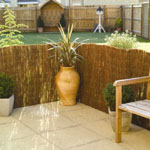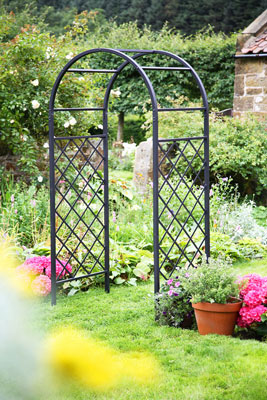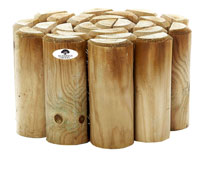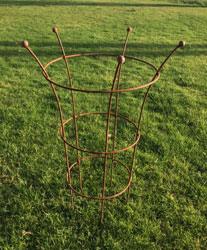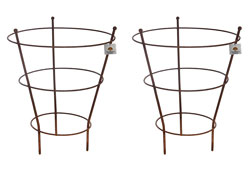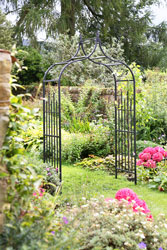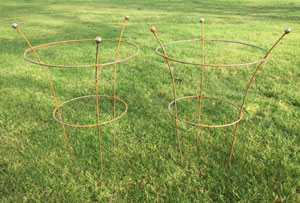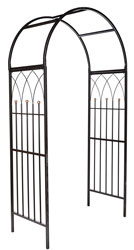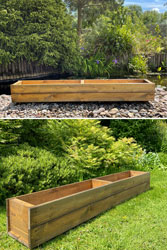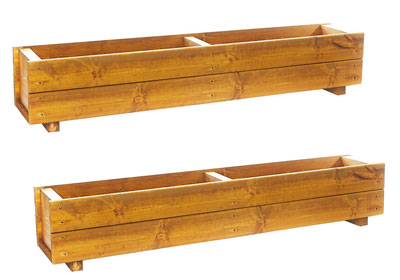
01757 28927301757 289273

UK Garden Supplies Bowland House, Ellerton, York, United Kingdom,
Garden Design Principles
Sculpture in the Garden
I believe that the creation of a really good garden is combining the natural and the man-made – the garden has to suit the house it goes with, but more than this there is a need to position artefacts such as screens, pergolas, summerhouses, and sculpture to compliment the shrubs, trees and other plants we us to clothe our gardens. It is the success of this contrast that will go a long way to turning a well designed and well planted garden into a place of true beauty and inspiration.
If you go back much more than 40 years you would find that most sculpture was found in the gardens of the large country houses and was mostly classical in nature, frequently fitted into suitable niches either of masonry or hedging. However the arrival of garden centres has seen to it that statuary is now much more eclectic both in form and material of construction. Further, the advent of sculpture parks has inspired many of us to create our own sculpture at minimal cost.
Generally speaking the old classical style sculptures whether made from stone or concrete tend to look better in a classical type setting as described above. When we come to the newer types there is no need to be so disciplined. Animals and birds, even if they are caricatures, look well on a lawn or close to a pond, my only reservation here is that if they are on the lawn, they will need moving before mowing.
There is a general feeling that most garden sculpture should perhaps be not immediately obvious, not exactly hidden by subtly placed so that you only see it when you are almost on it; certainly the element of surprise is always good in garden design.
A good garden sculpture on the other hand can provide an excellent focal point, and if you have a long straight path can usefully be placed at the half way point which will dissuade the eye from looking further on, effectively screening the long view.
Conditioning your Soil
The next few blogs will aim at how to grow excellent vegetables, flowers, trees and shrubs. But before you can do any of this, it is very important to have top class soil in which to grow your plants.
The first job is to get to know your soil, is it stony? Is it well or poorly drained? Is it acid or alkaline? Does it contain much humus?
If it is stony, remove the largest stones as you go, but don’t worry about smaller ones unless you want to grow carrots or parsnips to exhibit, if they are just for the table a few bends and divided roots are probably not worth the effort of removing lots of pebbles.
Drainage wants to be fairly good so that the soil is not waterlogged except at the end of a prolonged very wet spell. To improve drainage add sharp sand (not builders sand), even a little fine gravel (unless exhibiting carrots!), and organic matter (compost, manure etc). The quantities of these you need will be fairly large, up to 10kg per square meter for the worst soils. If the soil dries out very quickly because it is stony or sandy, then add organic matter to improve matters.
The amount of humus in the soil is important because this is the major source of food for your plants. To get an idea of how much there is take about a desert spoonful of the soil and break it up in 250 mls (a pint) of water, when it is thoroughly mixed with the water leave it for 15 mins to settle. Most of the soil will sink to the bottom, but some should be floating on the surface of the water – this is the humus. If there is none, add organic matter, and there is no such thing as too much humus!
Finally acidity. This is measured on the pH scale, 7 is neutral, less than 7 is increasingly acidic (vinegar is about 4.5), and more than 7 is increasingly alkaline (up to 14 for strong caustic soda). Most soils will be between 5 and 9. The pH will determine which plants you can grow, you will not grow rhododendrons in an alkaline soil, you will not grow daphnes in an acidic one, so don’t waste time and money trying. The only reliable way to know the pH is to test it with a meter (£7.99). Follow the simple instructions that come with the meter. pH can be adjusted within limits, lime will make it more alkaline, and there are products available to make it more acidic – but be aware the only way to make a big change last is to have a dedicated container, which is not in direct contact with the wrong pH soil.
There is more to this subject if you want to read further, minerals, insect and worm life are important for instance, but get the above things right and you will have every chance of great success
How to Appreciate a Garden you are Visiting
When you visit a garden, what do you think about? Do you just superficially look at the garden and think I like this or I don’t like that? That’s fine if you do but you can perhaps get more out of the experience.
First of all realise that there are two types of garden the plantsman’s garden, and the designer’s garden.
The former will have plants that the owner particularly likes and in most cases probably some considerable rarities; effort will have been made to combine these plants in artistic ways, bearing in mind their colours, forms, foliage, time of flowering and so on. If you are in this type of garden look to see if you like what has been achieved and if you do, look for what it is that makes it work for you is this something you can re-create in your own garden? Look particularly for plant associations perhaps a highly coloured flower contrasting with a plant of silvery foliage, or maybe a series of large leaved foliage plants giving a tropical feel.
In a designers garden look for the aspects of garden design hat we have looked at in the past few weeks does the designer favour the oriental, classical or modern approach. Watch for hidden views, maybe framed through a gateway or arch. How has the designer encouraged you to want to explore the garden? Are there garden rooms or does the overall design gradually unfold as you go round corners and past larger trees and shrubs?
In either case it is a good plan to make a couple of notes or take a photo or two to remind you later what you did or didn’t like. What do you think the gardener’s overall plan was? Do you think this was achieved well, only just or not really at all?
Of course a lot of the gardens you will visit belong to big estates where a lot of money is spent making spectacular gardens to attract visitors, and these often have aspects of both the designer and the plantsman, but usually one predominates. Can you tell which?
At the end of the day don’t forget that the main point in visiting gardens is pleasure, so enjoy it and if you can come away a little bit wiser and with an idea or two for your own garden that is a bonus.
Modern English Garden Design
Most of the main components for modern English garden design have been seen in the previous 13 blogs, things such as the miniaturisation of nature, borrowed views and not being able to see all the garden at once all coming from the Chinese and Japanese schools; formality and statuary from the classic Italian and French schools; and then aspects of the English landscape in larger gardens and cottage gardens in plots of any size.
However we need to add one final major component, the perennial herbaceous border. This was developed mostly in 20th century England as an alternative to the predominantly annual nature of the cottage garden. It is most commonly encountered on a grand scale in the large gardens of stately homes. However, the more structured approach to the herbaceous border where taller plants are at the back, shorter ones at the front, the planting of groups or drifts of a single plant and an attempt at colour harmony are frequently adopted in most garden beds which typically contain a mix of annuals, perennials, bulbs and even shrubs.
Combining aspects of these eclectic styles without clashes and disharmony can be very hard if not impossible to achieve, so this has led to the modern trend of “garden rooms” where separate areas are screened from each other and so little continuity is required. This also helps in not being able to see everything at once. The advent of garden rooms has increased the popularity of themed areas – most famous example the white garden at Sissinghurst.
It is, however, true that the very best garden designs are those where one area flows into the next with some elements of continuity and limited changes at each turn. This can be achieved with winding paths and screening provided by shrubs and trees rather than the rigid formality of a hedge, so the overall plan is still loosely a series of rooms, but perhaps rather more open plan rooms rather than walled rooms.
The increased affluence of today’s gardeners combined with the recent technical advances means that even the smallest plot can be provided with outdoor lighting, impressive water features, outdoor music and even artificial scents.
Japanese Tea Gardens
Japanese tea gardens are among the oldest designs in Japan originating in the 14th century.
In its most basic form the tea garden consists of a gate (ideally with a shelter of some kind) where the guests wait for their invitation to go to the tea house. Having received the invitation and passed through the gate, the visitor then follows a winding path along which he is supposed to meditate and so arrive at the tea house in a sufficiently relaxed state to take full part in the ceremony with none of the tensions and stresses of the outside world to distract him.
On arrival at the tea house the guest will be encouraged to wash his hands and rinse his mouth, thus to be in perfect physical as well as mental state.
In the very best tea gardens, the path will be narrow and winding progressing steadily upwards until the tea house at last comes into view. The path ideally represents a cool mountain path, and is generally kept damp to simulate spray from mountain streams and dampness from recent mists. A babbling stream with rocks and small waterfalls is seen as almost essential, and mossy glades, simple log or plank bridges, and decaying stumps complete the picture.
Vegetation is kept simple, trees and shrubs ideally being small as well as old and gnarled. Ferns are appropriate for the damp mountain atmosphere, but only the smallest and least intrusive of flowers and then only in very small numbers. There should be no bright or garish colour anywhere, this would disturb the required meditation and introspection.
Gate with shelyter wait for invitation
Path to encoutrage meditation, reminiscent of remote mountain path, no distractions
Symbolism and Culture in Chinese Gardens
The design and detail of a Chinese garden is usually heavily laden with culture and symbolism, the vast majority of which is lost on virtually all non-Chinese. All we can hope to achieve in this short article is to give you a flavour and some ideas to research more fully. Wikipedia is, as usual, and excellent starting point, but also there are two excellent books on Chinese gardens The Craft of Gardens original Chinese text translated by Alison Hardie and The great Chinese Gardens by Fang Xaiofeng
The planning of a garden can be heavily influenced by the geomancer, feng shui and similar philosophies. This would dictate that the main building is on the northern edge of the garden, so that it has southerly views and that the most important feature of the garden is at its centre. Between these two and then further round the garden we find the winding paths and views that have been referred to in recent articles.
Three auspicious things are frequently seen as the backbone of good plantsmanship and these are plum, pine and bamboo. Plum because its flowering is seen as the herald of Spring, pine is symbolic of longevity and constancy, and bamboo largely for the sound the wind makes as it passes between the stems and leaves.
In a classic garden nothing will be placed, or decoration made without a good reason. Everything is symbolic of other things, so the meaning is only apparent to the advanced scholar. So, for instance if we take dragons, the number of toes on each foot signifies the standing of the garden owner so a five toed dragon (known as the imperial dragon) can only belong to royalty, a four toed dragon to a nobleman and so on.
Similarly numbers have significance generally, so that 8 is considered a lucky number because it sounds similar to the word that means wealth or fortune, whereas the number 4 sounds similar to the Chinese word for death and so is considered unlucky. Colours also have significance; for instance green is associated with wood and the season of Spring, yellow with earth and the changing of seasons, and blue with water and Winter.
Animals also have significance. Cranes are symbolic of longevity, cockerel of fidelity and punctuality, the lion has religious connections as in temple lions, monkeys drive away evil spirits, and a rabbit represents hope.
So armed with this type of symbolism you cold now decorate a garden building with your own philosophy the only problem would be that only a Chinese person would understand what you were getting at!!
Constructions in Chinese Gardens - Part 2
Last week we looked at some of the buildings to be seen in a classical Chinese garden, and frequently two or more of these are joined by a covered walkway so that people enjoying the garden should not be troubled by either rain or the hot sun. The walkway may have open sides so that a continuous view of the garden is available, or it may have windows to look at discreet views that the designer wanted to show off. Occasionally, a wall runs down the centre of the walkway so that only one half can be seen at a time, although in some instances windows are placed in the central wall so that tempting glimpses of the other side can be seen.
This idea of tempting glimpses is further exemplified by the many types of ornamental windows encountered in buildings and walls. Such windows can be simple holes in the wall and as such come in a myriad of shapes from the purely round or rectangular to shapes with scalloped edges or even shapes that are representational of flowers or leaves. Some ornamental windows have a latticework centre, of wood, stone or concrete and again such latticed windows come in all sorts of shapes. The actual form of the lattice is seen as an important art form and may reflect the branches, leaves or other features that can be seen through the window.
Doors, like the windows are frequently ornamental in shape and are sited in carefully chosen places such that the view through the doorway is showing some feature to best effect. The circular “moongate” is perhaps the best known example of this but many other variants exist including gourd shapes and vase shapes
Chinese influences on Garden Design
China was the first to have a formalised school of garden design, as indeed it was first in many of the formalised arts and sciences. Classically, there are two main schools of Chinese garden design, the Royal Garden and the Philosopher’s Gardens.
The Royal Gardens are designed to impress and show off the vast wealth and good taste of the owner. They are invariably very large with large amounts of water, distant views and many buildings of exquisite architecture and opulence. Whilst fruit and flowers were grown these tended to concentrate in the working part of the garden and were rarely viewed by the royalty or their guests.
It is generally the Philosophers’ designs that are of more interest to westerners. Again these are very expensive to achieve, but have deep meanings behind many aspects and the symbolism is many –fold and deep in Chinese culture and folklore. One of the guiding principles was to mimic nature on a miniature scale, and one of the most commonly used inspirations was the yellow mountain landscapes with its precipitous mountains and valleys, along with the pine trees which cling on to these same mountains, without the luxury of soil. Add to this the need for water to complete the yin/yang duality of nature and we have the bones of the garden. A common way to achieve this backbone for the garden was to use stone classically from one particular lake in eastern China to create a series of paths and ponds which connected a series of buildings in which certain ceremonies could take place and artwork and treasures could be displayed. It was important the the path followed the most scenic route though the contrived landscape.
In the next couple of blogs we will look at the specific buildings that might be found in a Chinese garden and the way the symbolism was used to impress visitors.
The third Dimension - height
Height is the frequently overlooked dimension in the garden. Obviously there are tall plants - trees, and shrubs for sure but also the higher herbaceous plants such as sunflowers, hollyhocks, but these tend to need some sort of plant support. However beyond simply plants there are a wealth of possibilities.
There are things which can give height but don’t involve plants and therefore require little or no maintenance, statuary, sculptures and the like are examples. Otherwise you can grow various types of plants up a structure of some sort. Trellis and arches can support climbers as indeed can walls. An old shed or other eyesore(?) can be used to allow rambling roses or a mix of climbers free range.
There are a number of structures, many of which can be found on this website, which can be used for supporting sweet peas and the like, and if properly looked after these can provide a stunning effect as well as a summer long supply of highly perfumed flowers for the house. Try a series of 3 pyramids or obelisks of different heights for this purpose but do start the sweet peas early, and dead head religiously as well as keeping the whole plant trimmed.
An opposite to this arrangement is a series of plant pots spiralling up a vertical tube. This is planted up with trailing plants.
Finally if you have a wall or fence this will certainly be improved by being - dressed with plants, but this will be the subject of another blog.
Successful Plant Containers
Container plants are an essential part of summer on the patio but do you know how to get the best out of them?
First use good quality compost and mix in some water retaining crystals and some slow release fertiliser, the packets will tell you how much to use, but if in doubt use a handful of each for every 3 plants you are planting. Always put a couple of centimetres of compost on top of the compost containing water crystals as these are very unsightly after they have absorbed water, they look like little lumps of clear jelly!
When planting up do not economise on the number of plants you put in, the crowded look is what you need. We have a 35 cm diameter urn in our garden and we find this looks best with 8-10 plants. Use trailing plants around the edge and something to give some height in the middle, thereafter use colour form and leaf to get the effects you want.
In order to get the longest display you need to plant up in March, but only if you can then keep the containers in a warm area, an unheated greenhouse is a minimum. This way, when you put your container out at the end of May you should have large plants which are starting to come into flower. If you have nowhere to keep your containers warm, you will have to plant up in May and protect with polythene or bubble wrap until the end of the month and then you may not get flowers until July.
A container will need very regular watering, once every 3 or 4 days may be enough when the plants are small and the weather cool but in the height of summer when the plants have masses of leaves watering daily is essential. If you are going away you must fix up some irrigation, either a bottle of water dripping into the container, a proper irrigation system connected to a tap and with a timer. Failing either of these neighbours or offspring need to be pressed into service
Maintenance of the plants in the container is crucial to keeping a good display going through into September and October. Other than watering, two things are necessary and it is very important to do both of them early. First dead head, remove flowers which are going over, do not let them die completely and set seed or the plant will think it has served its purpose and stop producing any more buds. Secondly the compost and slow release fertiliser will last a well packed container no more than six weeks, so from 4 weeks on give a liquid feed at least twice a week. Many people use tomato fertiliser for this purpose as it is cheap easily available and convenient to use – usually just add a capful to your can of water, but do check the instructions!
Water regularly, dead head early, feed from 4 weeks. Omissions cannot be rectified you will have lost it!
Creating Micro Climates
Not all plants need the same growing conditions, some can’t stand the cold, some don’t like too much bright sunlight, some hate cold winds. The area in which you garden will have a climate determined partly by its latitude and its altitude but also modified by its exposure and its proximity to the sea, this climate will to a large extent control what you can grow easily.
It is, however, quite possible to modify the climate in parts of your garden to a small extent and hence widen the range of plants that you can successfully grow.
Perhaps the worst conditions in which to grow many plants is on an exposed coastal site the winds are frequently strong and salt-laden which many plants simply will not tolerate. On such sites it is common practice to plant a shelter belt of coniferous trees which can tolerate the conditions. Once the trees are high enough you can plant more demanding plants on the leeside the shelter will extend for approximately the same distance as the trees are high.
Similar shelter belts are useful in other exposed areas such as on hillsides or treeless flat plains. Shelter from wind is particularly necessary if you want to grow Japanese maples successfully.
In order to grow some more tender plants you may want to try planting them on a site open to the south (in the northern hemisphere) but sheltered from the north by a wall. Further shelter from east and west can help, and don’t underestimate the effect of the colour of the wall darker colours will absorb more heat from the sun during the day and give it off during the night, protecting your tender plants further.
If you have built a wall to give this protection, you will be pleased to know that a Morello cherry will thrive on the northern, cold side
Last week we looked at how to micro manage a climate to suit particular plants, but this may not go far enough to allow you to grow the full range of plants that you would like to grow.
You may garden on an alkaline chalky soil and want to grow acid loving plants, you may have a heavy wet soil and want to grow asparagus, or you may have a very stony soil and want perfectly shaped carrots! So what can be done?
Stony soils are usually the easiest to correct – simply dig the stones out, then they are gone forever and will not come back unless you dig the soil deeper.
With heavy soils again there is a fairly easy answer as long as the drainage is not too bad, add sharp sand (obtainable from garden centres , or builders yards if you need a lot). How much you need will depend on how heavy your soil is, try a kilogram for every three square metres rotovate or dig it in well and see if the result is light enough for you, if not add more. This cure will not last for ever and an annual top up of about a kilo per 10 square metres should maintain the situation.
Acid soils can be made alkaline by the addition of garden lime (note that this is not the same a builder’s lime which should not be used). A kilogram for every 8 square metres should be about right, but do invest in a pH testing kit which will easily allow you to check the result very accurately. Again annual top ups will be required – about 25% of your initial dosage every year is a good guide, but keep a check with the pH kit.
Finally to acidify a soil is generally the hardest and least successful of these treatments as the acidifiers tend to wash away very quickly. Raised beds can help a bit but are not worth the work involved if you don’t want the bed raised for other reasons. There are preparations available to acidify soil and they do work, but regular treatment will bee required, usually 3 or 4 times a year, and a foliar spray may be needed in addition.
Focal Points In Your Garden
The objective of a focal point in a garden is to provide something dramatic or interesting to attract the eye when you first see the garden. You will then subconsciously relate all the spaces of the garden to this focus. Clearly the focal point needs to be visible from the point at which most people catch their first sight of the garden – most likely the lounge window.
The focal point of a small garden is likely to be very different to that of a large garden. In a small garden it needs to be something dramatic, maybe an urn filled with bright cascading flowers or a dramatic water feature – but be sure not to overdo the size, a huge water feature in a small garden will look clumsy and ostentatious.
The focal point of a large garden is frequently less dramatic and further away. For example in our garden we have a sundial on a plinth about 100 m from the house and on the far side of a raised island bed and beyond the orchard. Gaps in foliage are deliberately left so that the sundial is clearly visible. Beyond the sundial we have cleared a small section of boundary hedge so that the view extends to our neighbours’ horse paddock. The effect of all this is to draw the eye to the furthest extremity of the garden and beyond, whilst most of what is beyond 30 m from the house is hidden by the raised bed. The idea being to make people want to go beyond the island bed to see what is there.
A tree or shrub can be a focal point if is sufficiently different to the things around it, but beware if you are using flowers or foliage for the effect as they do not last all year. This can, however give you the opportunity to have a focal point which changes with the season.
The Courtyard Garden
The Courtyard Garden ot The small backyard
There are 1000’s of terraced houses that have small backyard that was originally the place to wash, prepare vegetables and carry out many of the dirtier or wetter household chores. Nowadays the tasks that were performed here usually take place in the kitchen freeing up the yard from its purely utilitarian past, but few people make the effort to brighten the yard up and so put many thousands of pounds extra value onto their property.
There are two nearly universal problems in creating a garden in such a yard - lack of much bright sunlight and high surrounding walls. These problems do limit what you can do, but given some modern materials and a bit of imagination small miracles can be made to happen.
First, paint the walls with a bright, pale reflective paint - choose the colour carefully, it doesn’t have to be white! You can, if you are sufficiently talented, paint a mural - maybe a seaside scene, or rolling hills.
Next consider what you want to do in your garden - play with children, sit out , barbeque, etc. How would you do these if you had a conventional garden? Now how can you adapt these ideas to your yard garden?
Here are a few ideas that have been tried and tested:
Put a raised bed in the part of your garden which gets most sun - plant bright, ideally white or yellow flowered plants.
Put significant numbers of baskets, mangers or other containers on the other walls and where the light is not so great make sure you fill them with shade tolerant plants. Anyone who has seen the typical courtyard gardens of southern Spain will know how important it is to have numbers of these containers, not just one. If you are worried about watering install an automatic system, they are cheap to buy and simple to set up
If you would ideally like a lawn, use the artificial grass now available (like Astroturf). This is very hardwearing and will last for many years if it is laid properly onto a suitable bed. Instead of mowing it, you vac it!
Replace the concrete of your yard with riven stone effect flags, this will instantly change it from being a yard to being a patio. If laying flags on top of the concrete make sure you do not come above the damp proof course of the house. Small gaps between flags can be planted with suitable plants (stonecrops do well in this environment).
Place any statuary, birdbaths etc at the edge of the yard and not in the middle.
There are 1000’s of terraced houses that have small backyard that was originally the place to wash, prepare vegetables and carry out many of the dirtier or wetter household chores. Nowadays the tasks that were performed here usually take place in the kitchen freeing up the yard from its purely utilitarian past, but few people make the effort to brighten the yard up and so put many thousands of pounds extra value onto their property.
There are two nearly universal problems in creating a garden in such a yard - lack of much bright sunlight and high surrounding walls. These problems do limit what you can do, but given some modern materials and a bit of imagination small miracles can be made to happen.
First, paint the walls with a bright, pale reflective paint - choose the colour carefully, it doesn’t have to be white! You can, if you are sufficiently talented, paint a mural - maybe a seaside scene, or rolling hills.
Next consider what you want to do in your garden - play with children, sit out , barbeque, etc. How would you do these if you had a conventional garden? Now how can you adapt these ideas to your yard garden?
Here are a few ideas that have been tried and tested:
Put a raised bed in the part of your garden which gets most sun - plant bright, ideally white or yellow flowered plants.
Put significant numbers of baskets, mangers or other containers on the other walls and where the light is not so great make sure you fill them with shade tolerant plants. Anyone who has seen the typical courtyard gardens of southern Spain will know how important it is to have numbers of these containers, not just one. If you are worried about watering install an automatic system, they are cheap to buy and simple to set up
If you would ideally like a lawn, use the artificial grass now available (like Astroturf). This is very hardwearing and will last for many years if it is laid properly onto a suitable bed. Instead of mowing it, you vac it!
Replace the concrete of your yard with riven stone effect flags, this will instantly change it from being a yard to being a patio. If laying flags on top of the concrete make sure you do not come above the damp proof course of the house. Small gaps between flags can be planted with suitable plants (stonecrops do well in this environment).
Place any statuary, birdbaths etc at the edge of the yard and not in the middle.
The Courtyard Garden - Part 2
Last week we looked at the enclosed courtyard, the typical backyard of many an older townhouse, this week we will deal with a more open type of hard floored area such as may be found in front of garages, stables, barns or other garden buildings.
Here light is less of a problem than in a backyard surrounded by tall walls, but the first consideration now must be the type of hard surface required. Concrete may be essential if horses or other animals are around so that any fouling can be swilled away, otherwise concrete is best avoided. Flags or setts may be good if there is to be much traffic, but generally a mixture of surfaces will give the most pleasing effect. So maybe a flagstone path where people will walk, especially if likely to be pushing wheelbarrows, prams, buggies or wheelchairs with gravel areas where access is less likely to be required. Boundaries between the flags and gravel areas should not involve long straight lines unless a particularly formal style is being sought. If using gravel, do lay weed suppressing blanket on the ground before spreading the gravel and do not make the gravel more than 50mm deep otherwise it will be hard to walk on and any wheels are likely to become bogged down. While at this early stage in the construction, consider what use the courtyard will get during the dark evenings of winter – now is the time to build in any garden lighting that may be required
Planting of the courtyard can be through the gravel (by cutting a cross in the membrane), in beds up against the buildings, consider climbers here, or in flagged areas the occasional flag can be left out and soil brought up close to the surface for direct planting. It is important to get the scale of the plants right, we do not want massive trees or shrubs in a small courtyard, nor only tiny plants in a large one.
Now the courtyard needs to be dressed. Planters of all types , free-standing or attached to building walls, statuary , sundials , or other garden ornaments , cartwheels may be particularly suitable.
If your courtyard is large enough it may well be improved by the addition of a feature such as trellis , a pergola, a arch over a pathway or an obelisk to add an element of height. If there is a corner which can be screened the courtyard may even be the place to have your greenhouse or cold frames
Labour Saving Gardens
There are a number of ways in which you can create a virtually labour-free garden without having to resort to the classic concrete the whole thing over!
Your biggest ally in the quest to reduce maintenance is the weed suppressing blanket which is available in rolls of various widths. If you cover all the areas of your garden which are not hard landscaped with this, weeds are almost eliminated at a stroke, the only weeds that will come will be from wind borne seeds. We live in the country and last year covered about 100m2 (1000 ft2) with this and I guess we have had to remove about 20 weeds during the course of this summer
You can plant trees or shrubs through the blanket by cutting a cross with a knife and then planting as normal, and other than maybe a bit of tidying up in the autumn these will require little or no maintenance. Perennial plants can be almost as good but will eventually need to be lifted and divide but this is probably only every 3 or 4 years, and they will also flower longer if you dead-head them when the first flowers die off. Annuals we find to be better planted in any areas where the blanket did not reach especially if you are wanting them to self-seed for subsequent years.
Trellis can be erected with the posts going though the blanket and climbers also planted through the blanket to create a screen.
Finally when you have finished planting it is time to hide the blanket and here again there are a number of possibilities, two that we use most frequently are gravel and wood chippings. Both can be walked upon, so if you plant suitably you can easily create a garden with winding paths. If you ever want to use two different surfaces use some sort of physical separation such as log roll edging or even a row of bricks no need for mortar unless it is on a steep slope.
Finally, do not think a lawn is low maintenance it needs cutting once a week in summer and edging as well as feeding, raking and whatever else you decide necessary to keep it pristine.
Garden Designs
If you have the opportunity to design a garden from scratch or even re-design a tired or uninspiring garden there is no need to be intimidated as with all big tasks it is a matter of breaking the project down into small do-able chunks.
First, make a list of the things you would like to be able to do in your garden, and features you would like to have. Consider games that need to be played, barbeques, patio, water features, how much time you wish to spend maintaining the garden (a future article will concentrate on labour-saving features). Do you want trees, shrubs, flowers, vegetables? Where, if anywhere do you want scent, colour, sound? Lighting at night for paths or a dramatic view from the house or drive?
Having got your list, now make an accurate plan of the garden and make lots of copies, so your ideas can evolve because you will never get it right first time!
The next stage can be the most important of all in getting a stunning design consider that you should not be able to see the whole garden at a glance, if something is hidden behind a screen such as a hedge/few shrubs/ fence panel etc. it will create a desire to see what is on the other side. A screen also be a device to hide sheds, compost heaps, or other eyesores! Consider also views from all the house windows and the road, driveway etc. Finally are there any long distance views you want to take advantage of? If not, do you perhaps need a focal point within the garden.
Now, armed with all this you should be in a position to start putting a few ideas down onto the plan. Try working with curves rather than straight lines unless you are after a formal or modern minimalist feel.
Future articles will deal with the processes that will allow you to transfer your ideas into reality on the ground.
Wheelie BIn Screening
Screens are an essential part of most garden designs as they not only hide eyesores such a wheelie bins from view, but can also be used to create that area of mystery that you cannot see from your initial view of the garden and make you want to see what is the other side.
The best garden designs combine a number of different screens in an apparently seamless way so that a series of rooms is created in the garden which opens up as you explore further. What you choose to use as a screen will not only influence the character of the finished garden, but will also determine how long it takes to achieve the effect, and how much maintenance will be required in subsequent years.
So what choices do we have?
1- The purely natural – trees and or shrubs. Ideal to create the winding path. Trees obviously take longer to establish than shrubs, but will require less maintenance. Trees under planted with shrubs can look very good and combine the best of both if you have the room.
2 - The very solid. Brick or stone walls are solid and robust, but expensive and labour intensive to build and generally look out of place in all but the largest of gardens.
3 - The fairly solid. Fence panels, all sorts of designs and sizes are available, simple to erect (using wooden posts and Met post spikes). Needs occasional painting with preservative.
4 - Trellis. This type of screen is much underused in small and medium sized gardens; it is instant in its basic effect, and can be clad in climbers which can give year-round colour and even scent. You have a wide choice of materials of construction to suit all pockets and design requirements. Maintenance is limited to painting every few years if you are not satisfied with the colour as supplied. Ideally run weed suppressing blanket along the trellis and plant through this and dress the surface with stone to keep climbers’ roots cool.
5 - Brushwood similar to fence panels, but tend to be lower so more use in hiding eyesores rather than creating completely hidden areas.
Wheelie bin screens are available as a specific product for anything from one to three bins.
So whatever you decide to do in your garden screens can greatly increase the visual effect without being too expensive or difficult to erect.


